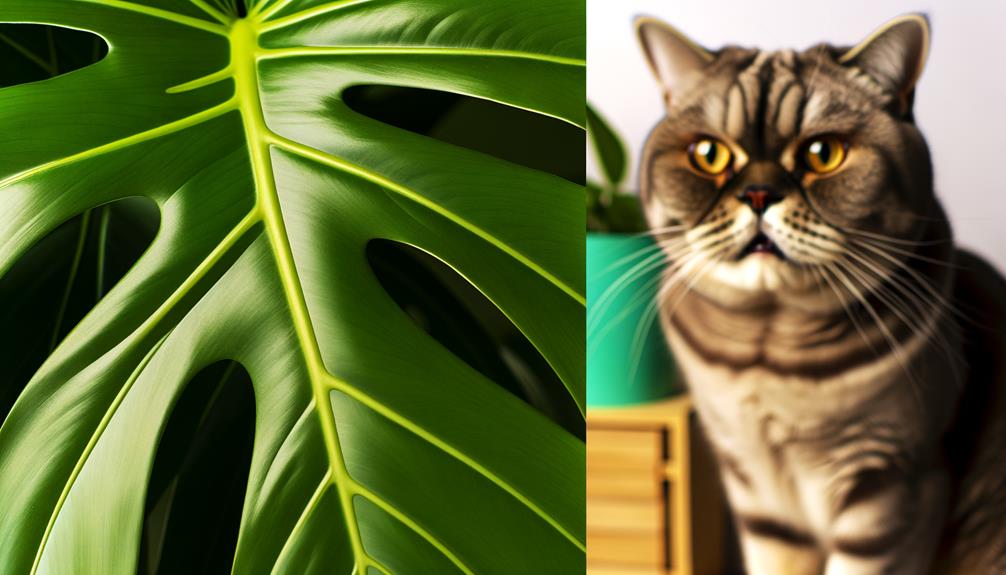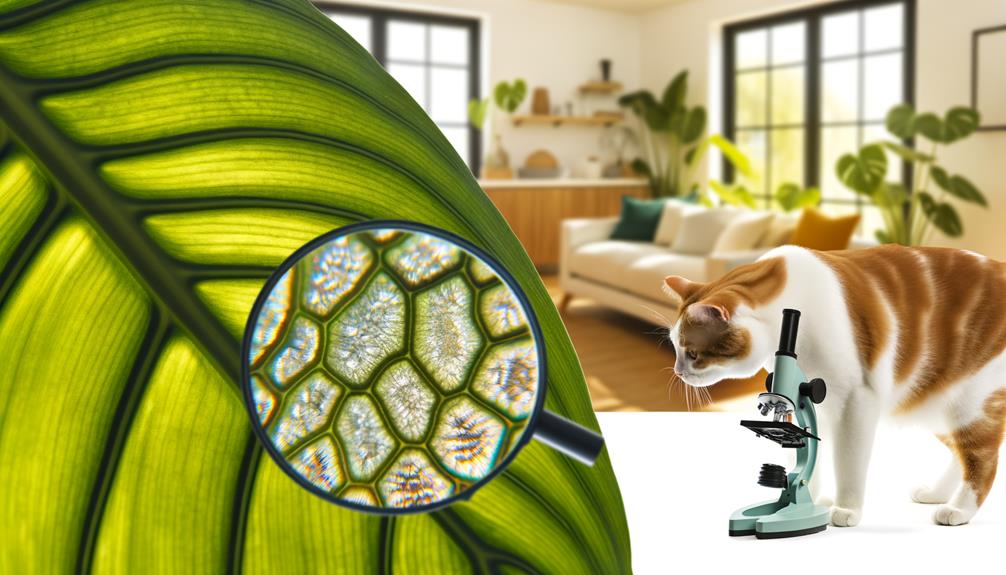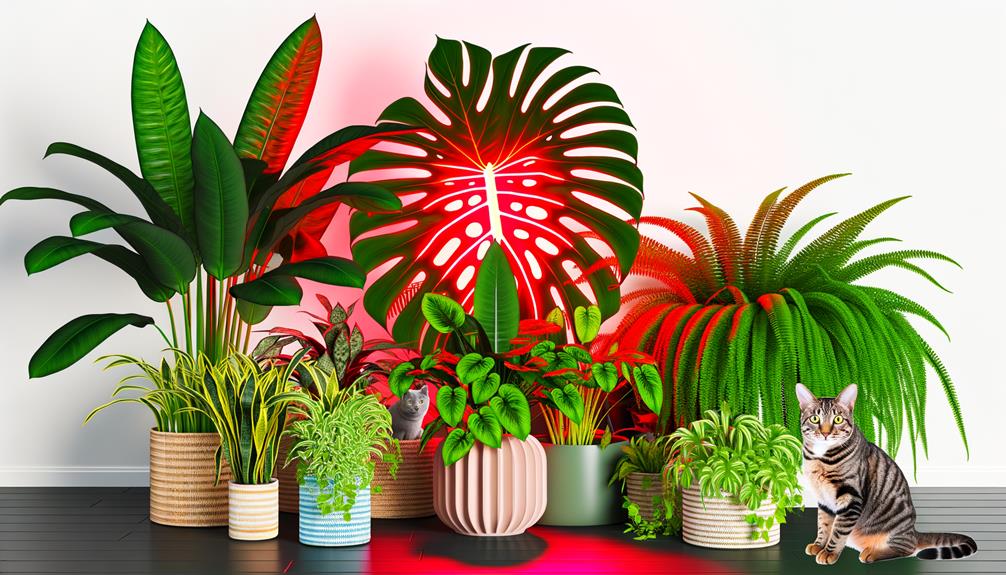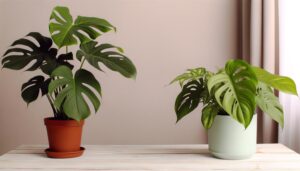Monstera Peru Toxic to Cats
Monstera Peru is highly toxic to cats due to insoluble calcium oxalate crystals. When ingested, these needle-like crystals penetrate your cat's mucous membranes, causing intense irritation.
Symptoms include drooling, vomiting, difficulty swallowing, and oral irritation. Immediate action involves removing the plant and contacting your veterinarian.
Chronic exposure can lead to kidney damage and persistent digestive issues. Consider safer alternatives like spider plants or Boston ferns to protect your cat.
For more details on preventing cat-plant interactions and ensuring pet-safe environments, you're encouraged to explore further.

Key Takeaways
- Monstera Peru contains insoluble calcium oxalate crystals that cause severe irritation when ingested by cats.
- Symptoms of poisoning include drooling, vomiting, difficulty swallowing, and oral irritation.
- Immediate actions include removing the plant, contacting a veterinarian, and providing fresh water.
- Chronic exposure can lead to long-term health effects like kidney damage and persistent digestive issues.
- Safe plant alternatives for cats include spider plants, Boston ferns, and Areca palms.
Why Monstera Peru Is Toxic

Monstera Peru is toxic to cats due to its insoluble calcium oxalate crystals, which cause intense irritation upon ingestion. When your cat chews on the plant, these needle-like crystals penetrate the mucous membranes in their mouth, throat, and gastrointestinal tract. This leads to severe irritation, pain, and potential swelling.
The chemical structure of calcium oxalate is such that it doesn't dissolve in water, making it persistently harmful. Research indicates that many Araceae family plants, including Monstera Peru, contain these crystals as a defense mechanism against herbivory. Understanding the underlying biochemistry helps you recognize the inherent risks.
Symptoms of Poisoning in Cats
When your cat consumes Monstera Peru, common symptoms include drooling, vomiting, and difficulty swallowing. You might also notice oral irritation, pawing at the mouth, and decreased appetite. These symptoms arise from insoluble calcium oxalates, which cause immediate discomfort upon ingestion.
| Symptom | Description | Frequency |
|---|---|---|
| Drooling | Excessive saliva production | Very High |
| Vomiting | Expulsion of stomach contents | High |
| Difficulty Swallowing | Struggling to swallow food or water | Moderate |
| Oral Irritation | Redness, swelling, and pain in the mouth | High |
Recognizing these signs early can help you access veterinary care promptly. The intensity of symptoms may vary, but understanding these clinical indicators ensures you're better equipped to act swiftly for your cat's health.
Immediate Actions to Take

Upon noticing any signs of poisoning, immediately remove the plant from your cat's vicinity and contact your veterinarian for guidance.
Avoid inducing vomiting unless explicitly instructed by the veterinarian, as this may worsen the condition.
Guarantee your cat has access to fresh water to help dilute the ingested toxins.
Transport your cat to the veterinary clinic promptly.
Provide the veterinarian with detailed information about the ingested plant, including its scientific name, Monstera karstenianum. This assists in administering the appropriate treatment.
Monitor your cat closely for any changes in behavior, respiration, or gastrointestinal distress.
Swift action and professional guidance are essential for mitigating the effects of Monstera Peru toxicity and safeguarding your cat's well-being.
Long-Term Health Effects
Long-term exposure to Monstera Peru can lead to chronic kidney damage in cats, characterized by reduced renal function and potential renal failure.
Additionally, persistent digestive issues such as vomiting and diarrhea may occur, disrupting nutrient absorption and overall health.
Evidence indicates that early intervention is critical to mitigate these long-term health risks.
Chronic Kidney Damage
Prolonged exposure to Monstera Peru can lead to chronic kidney damage in cats, manifesting through symptoms such as increased thirst, frequent urination, and lethargy. These symptoms indicate the kidneys' diminished capacity to filter toxins efficiently. Over time, the accumulation of oxalate crystals, which Monstera Peru contains, can cause renal tubule obstruction, leading to nephrotoxicity.
Studies show that oxalate-induced nephropathy is a significant risk in felines exposed to such plants. You'll observe weight loss, decreased appetite, and potentially elevated blood urea nitrogen (BUN) and creatinine levels in blood tests.
Early detection and intervention are essential to mitigate irreversible kidney damage. Consult your veterinarian immediately if you suspect your cat has ingested Monstera Peru.
Persistent Digestive Issues
Persistent digestive issues in cats exposed to Monstera Peru often manifest through chronic vomiting, diarrhea, and abdominal pain, indicating long-term gastrointestinal distress. These symptoms suggest persistent irritation of the gastrointestinal tract, possibly due to insoluble calcium oxalates present in the plant.
Over time, this can lead to malabsorption of vital nutrients, weight loss, and dehydration. Studies have shown that continuous exposure exacerbates these symptoms, making timely veterinary intervention vital. Cats might exhibit lethargy and a diminished appetite, further complicating their health.
It's crucial to monitor your cat closely if you suspect ingestion and consult a veterinarian immediately. Effective treatment typically involves hydration therapy, antiemetics, and dietary adjustments to manage and mitigate these persistent digestive issues.
Safe Plant Alternatives

You can guarantee your cat's safety by selecting pet-friendly houseplants like spider plants, Boston ferns, and parlor palms. These non-toxic greenery options offer aesthetic appeal without compromising your pet's health.
Studies confirm their safety, making them excellent alternatives to Monstera Peru.
Pet-Friendly Houseplants
When selecting pet-friendly houseplants, consider options such as spider plants, Boston ferns, and areca palms that are non-poisonous to cats.
Spider plants (Chlorophytum comosum) are resilient and flourish in various lighting conditions. Scientific studies confirm their non-poisonous nature to cats, making them safe for inquisitive pets.
Boston ferns (Nephrolepis exaltata) not only improve indoor air quality but are also gentle to felines.
Areca palms (Dypsis lutescens) are another superb choice; they create a tropical atmosphere and pose no danger to your cat's health.
Always validate plant safety through credible sources, as some plants have doppelgangers that might be harmful.
Opting for these pet-friendly houseplants guarantees a harmonious and secure living environment for your feline companions.
Non-Toxic Greenery Choices
Several non-toxic plant alternatives provide both aesthetic appeal and safety for your feline friends. Consider incorporating Spider Plants (Chlorophytum comosum) into your home. These resilient plants are safe for cats and can thrive in various light conditions.
Boston Ferns (Nephrolepis exaltata) are another excellent choice, offering lush, feathery fronds without posing any toxic risk. Additionally, the Areca Palm (Dypsis lutescens) can add a tropical touch while ensuring your cats remain unharmed.
African Violets (Saintpaulia) provide vibrant blooms and are completely safe for pets. Each of these plants has been studied and confirmed non-toxic by the ASPCA, giving you peace of mind.
Preventing Cat-Plant Interactions
Creating a barrier between your cat and Monstera Peru can greatly reduce the risk of toxic interactions. Utilize physical barriers such as plant cages or elevated shelving to restrict access.
Behavioral training can also be effective; employ positive reinforcement to discourage plant chewing. Monitoring your cat's behavior around plants is essential.
According to research, environmental enrichment can divert a cat's attention from harmful plants. Introduce cat-safe alternatives like cat grass or catnip to satisfy their natural curiosity.
Additionally, consider using deterrent sprays that are safe for pets but discourage plant interaction. By implementing these strategies, you can create a safer environment for your feline companion while still enjoying the aesthetic benefits of Monstera Peru.
Conclusion
To sum it up, Monstera Peru is toxic to cats, causing symptoms like drooling, vomiting, and difficulty swallowing.
If your cat shows these signs, act immediately by contacting a vet. Long-term effects can be severe, so prevention is key.
Opt for safe plant alternatives like spider plants or Boston ferns.
Remember, an ounce of prevention is worth a pound of cure—keep your feline friends safe by minimizing their access to potentially harmful plants.






